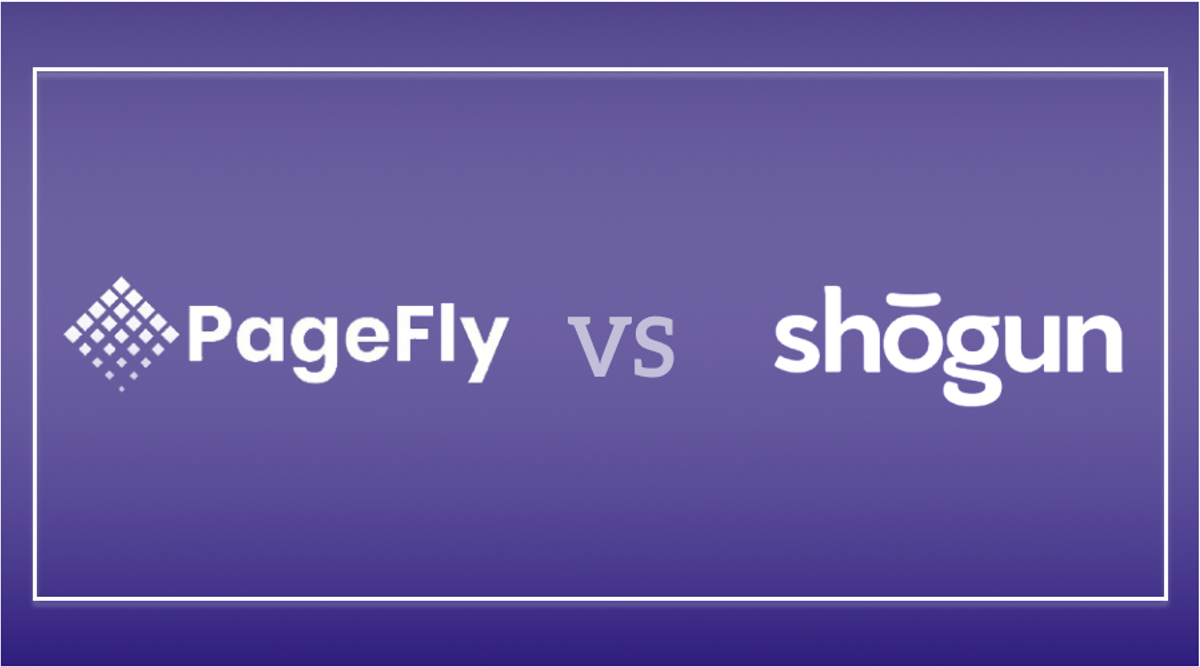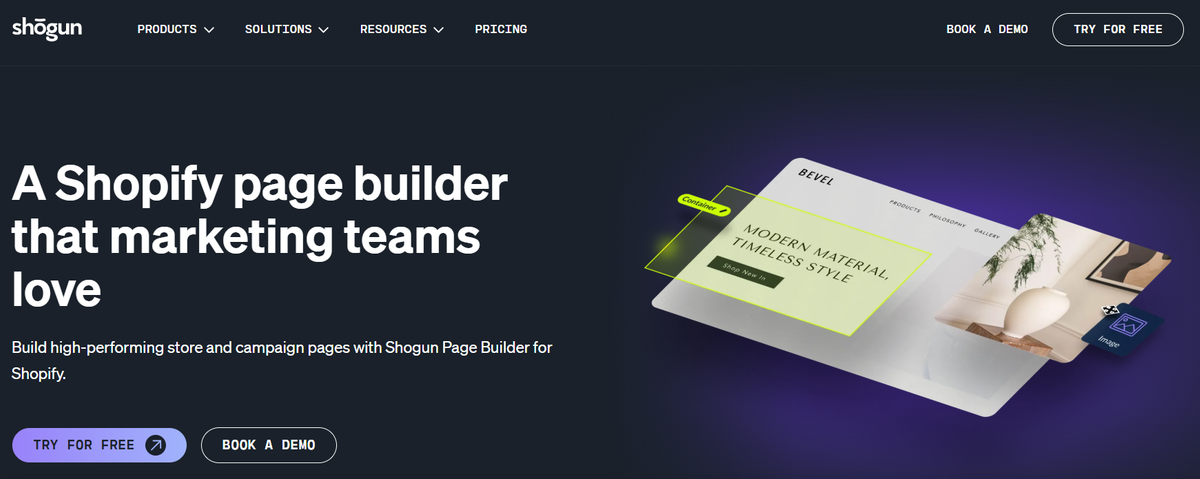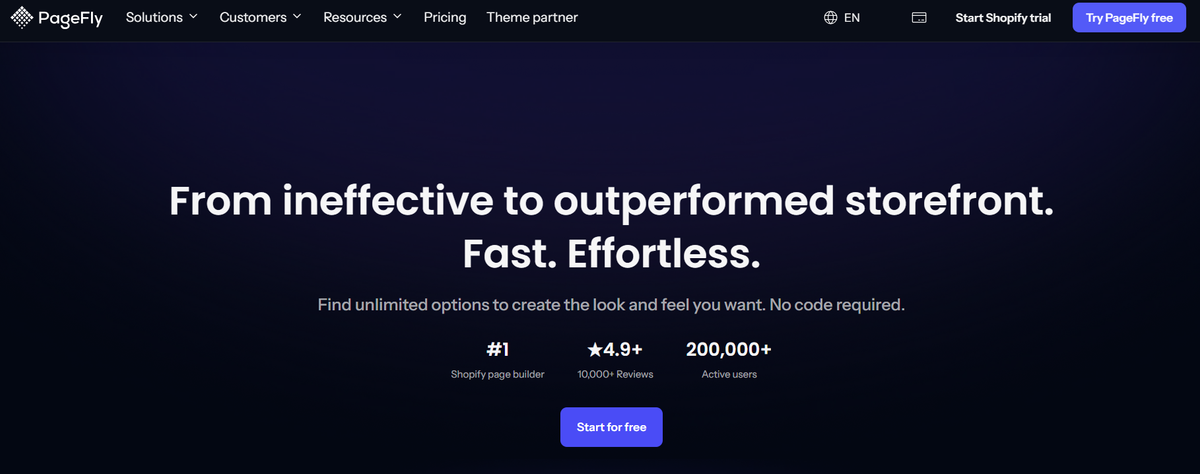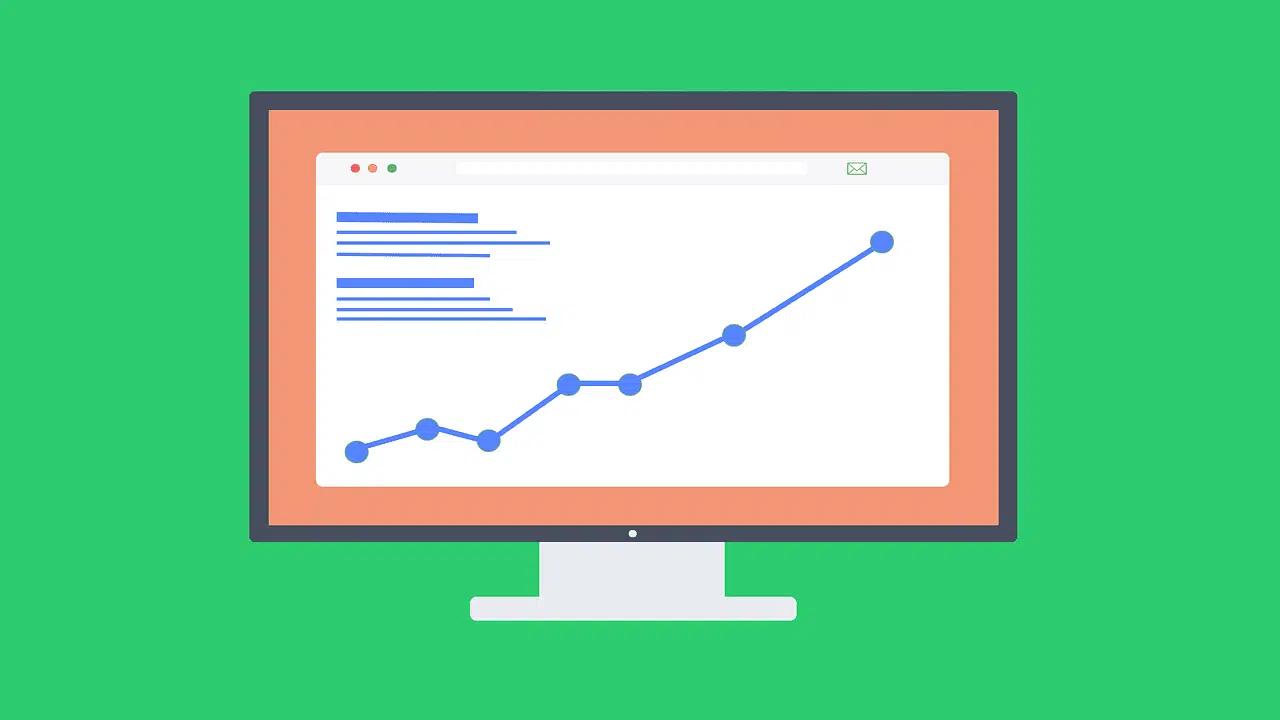You launch a Shopify dropshipping store loaded with products, but the product and landing pages feel off, and visitors bounce. Among the Best Apps For Dropshipping, page builders like Shogun and PageFly shape how customers see your brand, how fast pages load, and how easily you can run A/B tests. Which tool gives you smooth drag and drop editing, mobile-friendly templates, solid SEO options, and sensible pricing for your growth? Compare Shogun and PageFly across templates, performance, customization, analytics, and support so you can pick the page builder that fits your Shopify goals.
To speed that choice, PagePilot's AI page builder can auto-create optimized layouts, suggest templates and copy tweaks, and help you test pages faster so you hit better conversion rates without the technical hassle.
Shogun Vs PageFly at a Glance

When choosing between Shogun and PageFly, start by considering the type of pages you want to create and optimise, whether that’s product pages, collection pages, your homepage, or custom landing pages. Both are all-in-one Shopify page builders, but they differ in design focus, analytics, ease of use, and cost.
Design & Templates
Shogun offers high-quality templates and a polished design experience, ideal if you want a more premium look out of the box. PageFly’s design capabilities are strong, but its main advantage is simplicity and an intuitive drag-and-drop interface.
Analytics & Testing
Shogun comes with built-in analytics and split-testing tools so that you can monitor performance without extra integrations. PageFly requires third-party tools for the same level of tracking and testing.
Pricing
Shogun sits at the higher end of the pricing spectrum. PageFly is more budget-friendly and even offers a free plan, making it accessible for smaller stores or those just starting.
Best Fit Use Cases
Choose Shogun if you need integrated split testing, deeper analytics, and a premium template set for high-value product pages. Choose PageFly if you want a lower cost, user-friendly builder that scales through third-party CRO and analytics tools. Which of those trade-offs matters most for your store right now?
Related Reading
- Best Apps For Dropshipping
- Is Dropshipping Still Profitable
- How To Start Dropshipping For Free
- Where To Buy Dropshipping Products
- Is Amazon Dropshipping Profitable
- How To Find Dropshipping Products
What is Shogun?

Shogun is a Shopify page builder app introduced in 2015 that gives merchants a drag-and-drop editor to build landing pages, product pages, and custom content without deep coding. It supplies a library of templates, reusable sections, and page elements like video embeds, image galleries, accordions, forms, and countdown timers. The editor adapts to any Shopify theme and outputs mobile-responsive pages that integrate with your store catalog and checkout.
Core Features That Matter for Conversion
Shogun emphasizes conversion-focused features. You get A/B testing, analytics hooks, and conversion elements designed to improve landing page performance.
The app supports SEO controls, custom code blocks for developers, and integrations with marketing and analytics tools. You can publish pages to multiple domains or stores, manage user permissions for teams, and collaborate with developers while still letting marketers edit visually.
Pricing, Positioning, and Target Users
Shogun targets mid-market and enterprise merchants. There is no free plan, and the tiered pricing unlocks advanced conversion tools and collaboration features at higher levels. That makes Shogun a fit for stores that need multistore support, developer collaboration, and advanced testing rather than a solo seller on a tight budget.
How Shogun Compares to PageFly
Both Shogun and Pagefly are Shopify page builders with drag-and-drop editors, templates, and mobile-responsive output. Shogun leans toward enterprise features such as A/B testing, advanced collaboration, multistore publishing, and developer-friendly custom code access.
Pagefly often competes on lower entry cost and a simpler learning curve for small stores and solo merchants. Considerations when choosing include pricing tiers, page speed and performance, available templates, SEO controls, and how each handles custom code and integrations.
Practical Use Cases and Who Benefits Most
Use Shogun when you need high-fidelity landing pages, regular A/B tests, team workflows, or multi-regional store setups. Marketing teams can build pages without constantly pulling developers, and development teams can inject custom scripts where needed. Smaller stores may find the cost restrictive and prefer alternatives that focus on affordability and simpler feature sets.
Want a feature checklist tailored to your store size and conversion goals? Which elements matter most for your product pages or landing campaigns?
What is PageFly?

PageFly is a drag-and-drop page builder for Shopify that lets you build homepages, product pages, collection pages, blog pages, and dedicated landing pages without writing code. Start from blank or pick one of 100-plus conversion-focused templates, then adjust spacing, buttons, animations, and layout in real time. Advanced users can add custom CSS or tweak the code editor for pixel-perfect control.
What Makes PageFly Stand Out in Practice
The editor combines fine visual control with quick templating. You get reusable section blocks, responsive controls for mobile and tablet, and detailed element settings so product pages look polished and focused on conversion. The app also supports dynamic content and works with Shopify’s theme structure so pages feel native rather than bolted on.
Performance, Analytics, and App Integrations
PageFly includes built-in analytics to track page views, conversion rate, and revenue per page, which helps prioritize tests. It integrates with standard Shopify tools for reviews, email, upsells, and CRO so that you can connect Klaviyo, review apps, and funnel builders without awkward workarounds. Pay attention to page load times when adding heavy media; PageFly gives control, but optimising images and scripts still matters.
Support, Pricing, and Workflow Notes
PageFly offers a generous free tier and responsive 24/7 support, including live chat on lower plans. That makes it handy for dropshippers who need fast changes and troubleshooting during launches. If you use repeated templates across many listings, the ability to save and clone sections speeds up scaling.
Shogun vs PageFly: Practical Differences for Store Owners
Both are top Shopify page builders, but they target slightly different needs. PageFly often wins on price flexibility, template variety, and a lower learning curve for rapid product page builds.
Shogun tends to position itself toward larger merchants with enterprise features like built-in split testing and workflow automation on higher tiers, which can justify its cost for stores that need those capabilities. Ask yourself:
- Do you need advanced A B testing and enterprise integrations
- Do you want fast, conversion-oriented pages and rapid time-to-market?
Best use cases for dropshipping stores
Use PageFly when you need to launch product pages quickly, test different layouts, and keep costs low. The drag-and-drop editor and template library let you iterate product descriptions, images, and funnels without a developer. For stores that require heavy experimentation on ad funnels and rapid creative swaps, PageFly reduces friction so you move faster.
Want a fast comparison to your current setup?
Try building one product page on PageFly and one on your theme or another builder to compare load times, mobile behavior, and conversion elements. Which editor lets you change a hero image, update bullets, and duplicate the layout the fastest while keeping desktop and mobile consistent?
Try PagePilot’s Free Test Drive
Use PagePilot’s AI page builder to test products, ideas, and angles faster by giving our AI a competitor or supplier URL, and we will create a high-converting product page using the info found on that site and upgrade visuals with our AI Product Image tool so you no longer compete with the exact copy and images. Start a FREE Trial and generate 3 product pages for free today (no credit card needed).
Key Differences Between Shogun and Pagefly

PageFly focuses on simplicity and a Shopify-first approach, with an easy drag-and-drop editor, an extensive template library, and a friendly price for small stores. Shogun targets mid-size and enterprise merchants who need advanced front-end control, built-in split testing, analytics, scheduling, and multi-platform support for Shopify, BigCommerce, and Magento. Which trade-offs matter more for your store and team?
Drag and Drop Builder: Who Builds Faster and with Less Headache
PageFly
You get one of the cleanest drag-and-drop editors on Shopify. Non-technical users pick it up quickly and compose pages using an extensive elements library that includes countdown timers, testimonial carousels, custom forms, product listings, slideshows, and CTAs. You can freely rearrange or remove blocks without breaking layouts, so iteration moves fast and you rarely need developer help.
Shogun
The editor is polished but leans toward more technical flexibility. It includes sections, columns, sliders, tables, icons, HTML and JavaScript blocks, product pages, forms, and add-to-cart components. That extra control helps when you need complex product templates or custom code to match specific commerce flows.
Which editor matches your comfort with layout design and custom code?
Templates: Variety Versus Out of the Box Polish
PageFly
Offers 70-plus templates covering homepages, product pages, collection pages, blogs, contact pages, and more. The focus is on flexible starting points you will tweak to match brand identity.
Shogun
Offers roughly 30 plus templates that land with a premium look immediately. Templates are highly editable at the section level, so you can adapt a smaller set into distinct pages without losing visual quality.
Do you want a wide selection to remix or a smaller set that looks ready to ship?
eCommerce Features: Integrations, CRO Tools, and Front End Control
PageFly
Built specifically for Shopify, with strong third-party integrations like Mailchimp, Loox, and Judge.me, Yotpo, and Stamped.io for reviews, upsells, and email flows. PageFly does not ship native split testing or analytics, so you rely on Google Analytics, Hotjar, or external A/B tools for conversion insights.
Shogun
Works with Shopify, BigCommerce, and Magento, and gives deeper front-end control that syncs with your store's back end. Shogun adds built-in split testing, analytics, and page scheduling so you can run conversion experiments and measure results inside the app without stitching tools together.
Which set of e-commerce capabilities shortens your optimization cycle?
Supported Platforms: Where You Can Use the Builder
PageFly
Shopify only. If you plan to migrate platforms later, you will need to rebuild pages.
Shogun
Shopify, BigCommerce, and Magento. That multi-platform support helps brands that run several storefronts or may change platforms later.
Are you committed to Shopify, or do you need future platform flexibility?
Split Testing: How You Run Experiments
PageFly
No native split testing. You must set up A/B testing externally using Google Optimize or analytics events, which slows iteration and requires more setup.
Shogun
Includes native A/B testing on higher plans so you can create multiple page variants, measure performance, and let data pick winners inside the app.
Do you want a built-in testing workflow or will you manage experiments with external tools?
Analytics and Metrics: Where You See Performance Data
PageFly
No built-in analytics dashboard. You connect Google Analytics, Hotjar, or other tools to track bounce rates, session behavior, and conversion events.
Shogun
Provides an in app analytics view with metrics such as bounce rate, sessions, add to cart events, and form submissions. That central reporting speeds decisions for small teams.
Which reporting approach reduces friction for your decision makers?
Pricing: Cost Structure and Plans
PageFly
Has a free plan with limits. Paid plans start at about 24 dollars per month with 24/7 support. An enterprise tier costs nearly 199 dollars per month and adds unlimited tracking sessions, speed optimization, and advanced support.
Shogun
No free plan, only a limited trial. Build plan begins at around $39 per month for basic page quotas. The Measure plan costs around $ 149 and adds analytics, scheduling, and more users. The Advanced plan, priced around $ 449, unlocks unlimited pages, more users, audit logs, and custom data collections. Pricing varies slightly by platform.
Which pricing path fits your budget and the features you need?
Platform Integrations and Extensions: Connectors That Matter
PageFly
Strong Shopify app ecosystem support and straightforward connections to review apps, email marketing, and CRO tools.
Shogun
Same review and marketing integrations, plus platform connectors for BigCommerce and Magento, and advanced features like image optimization, custom snippets, and user roles on higher plans.
What third-party tools must integrate with your page builder to keep your workflow intact?
Performance and Technical Control: Speed, Code, and Custom Blocks
PageFly
Optimized for Shopify storefronts with responsive editors and mobile-responsive controls. Limited built-in performance monitoring means you must test speed externally.
Shogun
Offers image optimization, custom code blocks, and more granular control over front-end performance. Built-in analytics help you tie changes to page speed and conversion.
Do you need hands-on control of speed and code or a faster setup with fewer technical options?
Optimization Workflow: From Idea to Winning Page
PageFly
Fast prototyping and easy edits let marketing teams spin up landing pages quickly. Testing requires external tools, so optimization cycles include extra steps.
Shogun
Combines page building, scheduling, split testing, and analytics in one workflow. That tight loop helps teams run experiments and deploy winners faster when they have the budget and headcount to use the features.
Which workflow shortens the time from test idea to measurable lift for your business?
Related Reading
- How To Use AI For Dropshipping
- How To Set Up A Dropshipping Business
- How To Find Winning Products For Dropshipping
- How Much Can You Make Dropshipping
- Dropshipping Business Ideas
- Best High Ticket Dropshipping Products
How To Choose The Best Page Builder for Your Dropshipping Store

If you test ten products a week, manual page building kills momentum. Look for builders with AI features that create product pages from a competitor or supplier URL, generate persuasive copy variations, and produce AI-enhanced product images.
PagePilot style tools can scrape a source page, assemble a layout, and suggest headline and feature blocks so you can test faster. Can the builder create a finished product page in minutes and supply image variants that avoid stock sameness?
Template Library That Matches Your Conversion Goals
An extensive, well-organized template library saves time and improves conversion. Seek templates labeled for product pages, landing pages, funnels, and promo events.
Templates should include ready-made sections like hero plus social proof, benefit grids, FAQ blocks, and sticky CTAs. Check whether templates are mobile first and whether you can save your templates or sections for reuse across multiple product tests.
Ease of Use While Keeping Control
Drag and drop and inline editing are table stakes. Look beyond that to how the builder handles global styles, reusable sections, and dynamic product data. Does it let you edit content directly on the live page? Can a team member with limited design skills spin up a page without breaking the layout? Will this tool speed up iterative testing without forcing developers to help?
Customer Support When a Launch is Slipping
Downtime or a builder bug can cost ad spend and launch momentum. Prefer builders with live chat, fast ticket responses, and a clear escalation path. Check genuine user reviews for responsiveness and technical depth. Does the vendor provide onboarding sessions, templates tailored to ecommerce funnels, and a knowledge base focused on Shopify dropshipping use cases?
Mobile Responsiveness and Page Load Performance
Mobile buyers dominate. Ensure every template and block is fully responsive and easy to tweak per breakpoint. Measure page load impact, some page builders inject heavy scripts that slow time to interactive and hurt conversions. Run sample pages through speed tools and compare render times. Which builder gives you clean output and fast mobile rendering?
SEO Friendly Structure and Technical Health
A builder must allow semantic HTML, meta control, image alt text, canonical tags, and fast URLs. Look for built-in schema markup and sitemap behavior. Does the builder let you control meta fields and avoid duplicate content traps?
Analytics, Testing, and Optimization Features
A/B testing, split URL tests, and native analytics can shave weeks off optimization cycles. Confirm integration with Google Analytics, GA4, Facebook pixel, and heatmapping tools. Can you track conversion funnels from ad click to purchase on a per-page basis? Does the builder support experiments without complex developer work?
Integrations, Reusable Elements, and Workflow Automation
Look for deep compatibility with Shopify apps you rely on: product review apps, upsell apps, subscriptions, payment gateways, and email marketing platforms. Reusable blocks and global sections let you clone top-performing modules across product pages. Does the builder support dynamic product sections that auto pull variants and inventory?
Security, Theme Compatibility, and OS 2.0 Support
Verify theme compatibility and Shopify Online Store 2.0 support. Some builders inject code that clashes with themes or third-party apps. Confirm how the builder handles liquid, CSS scoping, and editor conflicts so you avoid layout breakage when you switch themes.
Shogun vs PageFly — the practical comparison for dropshippers
Shogun vs PageFly shows common trade-offs you will face. PageFly often appeals to stores on tight budgets with a robust free or low-cost tier, lots of elements, and fast template assembly. Shogun tends to target higher volume stores and merchants wanting enterprise capabilities such as built-in split testing, more advanced analytics, and developer-level custom components.
Consider pricing, expected page volume, and whether you will need native A/B testing or can run experiments through external tools. Which app returns the best mix of speed, conversions, and predictable monthly cost for your ad spend level?
Performance and Cost Trade-Offs to Check Now
Compare editor speed, published page performance, storage limits, and how each app charges for pages or traffic. Test a sample product page on both builders and measure load time, edit time, and the amount of developer cleanup required. Which option lowers your time to first sale and keeps long-term maintenance low?
Practical checklist to make a decision today
- Can it produce a live product page from a URL or CSV quickly?
- Does it include AI copy or image tools to test variations fast?
- Are templates optimized for product pages, funnels, and promos?
- Is the editor intuitive for non-technical staff with global style controls?
- How fast are published pages on mobile and desktop?
- Does it let you control meta tags, schema, and canonical URLs?
- Are A/B tests and analytics built in or easily integrated?
- Does it integrate with your review, upsell, and email apps?
- What is the real cost once you scale to 50 100 product pages?
Answer these, and you will pick a builder that quickly turns product tests into profit. Which feature will cut your launch time the most and let you iterate next week?
Start a FREE Trial and Generate 3 Product Pages with Our AI Page Builder Today
Tell PagePilot a competitor or supplier URL, and our AI pulls headlines, benefits, specs, and images to assemble a high-converting product page. The builder creates a clean, mobile-friendly layout and fills sections that sell: hero, features, social proof, and a focused call to action. Want to test five angles fast? Generate three product pages for free right away with no credit card required.
Turn Generic Copy and Stock Photos Into Unique Assets
Are you tired of running the duplicate product copy and images like everyone else? PagePilot’s AI Product Image function upgrades visuals so your listing does not match the same creative that other stores use.
The AI refines backgrounds, lighting, and presentation while keeping product integrity. That reduces creative overlap with competitors using the same supplier assets and helps lift click-through and conversion.
How PagePilot Works Step by Step
Paste a competitor or supplier URL. The AI extracts product name, key features, reviews, and media. It then maps those elements into a product page template optimized for conversions. You can edit copy, swap images, and launch variants for A/B testing. The flow saves hours of manual copy work and image editing and lets you push multiple concepts into live traffic quickly.
Shogun Vs PageFly Vs PagePilot: Where Speed Wins
Shogun and PageFly are solid page builders, with rich drag-and-drop editors and fine-grained control. They work well for complete site design and advanced layouts. PagePilot aims at a different bottleneck: speed of product testing.
Instead of building pages from scratch, PagePilot auto-generates pages from URLs and image assets so you can iterate on creative and angles faster than you can with slow manual design cycles.
Practical Differences You Should Know
- Control vs automation: Shogun and PageFly give deep visual control and blocks. PagePilot gives near-instant pages with editable results.
- Learning curve: PageFly and Shogun require builder familiarity. PagePilot reduces designer dependency.
- Creative: PagePilot includes AI image upgrades to avoid using stock photos from suppliers. PageFly and Shogun rely on your supplied assets or manual editing.
- Testing speed: PagePilot is built for rapid multi-angle testing. If you want to scale ad tests fast, that matters.
Integrations, SEO, Mobile Performance, and Page Speed
PagePilot outputs mobile-responsive pages ready for Shopify themes. You can add tracking pixels and UTM parameters, and connect with analytics and email tools. The builder uses lazy loading and compressed assets to keep page speed low.
If you need custom code or an advanced schema, PagePilot supports inserts so developers can fine-tune SEO and performance.
When to Pick PagePilot and When to Use Shogun or PageFly
Choose PagePilot when you want many rapid product page variations, quick competitor cloning for angle testing, and automatic image upgrades. Choose Shogun or PageFly when you need pixel-perfect control over layout, complex landing pages, or heavy customization across a catalog. Which one fits your current goals, fast MVP tests or deep custom pages for a flagship product?
Start Your Free Trial and Create Three Pages Without a Credit Card
Sign up, paste a competitor URL, and PagePilot will generate a product page you can edit. Use the AI image tool to refresh visuals, duplicate the page, and create alternate angles for ads. The free trial includes three pages so you can run real split tests and decide what converts before committing to a plan. Want to try a specific competitor URL now?






